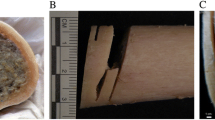Abstract
In case of gunshot wounds, forensic anthropologists and pathologists have many tools at hand, and the assistance that chemical and microscopic investigations can provide in such scenarios is often valuable and crucial. However, the results of such analyses in the search of gunshot residues (GSR) ought not to be acritically considered. We report five cases where chemical (sodium rhodizonate) and microscopic (scanning electron microscopy-energy dispersive X-ray spectroscopy (SEM-EDX)) analyses were performed for the search of GSR. Four cases concerned the forensic field and analyses on buried, charred, or submerged remains, whereas one case concerned the historical remains of a soldier of the First World War. In every case, the search for GSR with these techniques showed their persistence even after long periods and preservation in peculiar environments. However, chemical analyses provided their contribution, but in two cases, anthropological analyses provided crucial and solving results. The five cases show the indisputable usefulness of chemical and microscopic analyses in the search of GSR in gunshot wounds and especially how such residues may survive in time and in adverse environmental conditions. However, experts should always be dubious about some pitfalls (such as contamination) one can frequently find in these scenarios.





Similar content being viewed by others
References
Di Maio VJM (1999) Gunshot wounds. CRC Press, Boca Raton
Dodd MJ (2006) Terminal ballistics: a text and atlas of gunshot wounds. CRC Press, Boca Raton
Schwoeble AJ, Exline DL (2000) Current methods in forensic gunshot residue analysis, 1st edn. CRC Press, Boca Raton
Saverio Romolo F, Margot P (2001) Identification of gunshot residue: a critical review. Forensic Sci Int 119(2):195–211
Martiny A, Campos AP, Sader MS, Pinto AL (2008) SEM/EDS analysis and characterization of gunshot residues from Brazilian lead-free ammunition. Forensic Sci Int 177(1):e9–17
Dalby O, Butler D, Birkett JW (2010) Analysis of gunshot residue and associated materials—a review. J Forensic Sci 55(4):924–943
Grosse Perdekamp M, Arnold M, Merkel J et al (2011) GSR deposition along the bullet path in contact shots to composite models. Int J Legal Med 125(1):67–73
Marty W, Sigrist T, Wyler D (2002) Determination of firing distance using the rhodizonate staining technique. Int J Legal Med 116(1):1–4
Zoja R, Lazzaro A, Battistini A, Gentile G (2006) Detection of gunshot residues on cadaveric skin using sodium rhodizonate and a counter stain. Biotech Histochem 81(4–6):151–156
Gibelli D, Brandone A, Andreola S et al (2010) Macroscopic, microscopic, and chemical assessment of gunshot lesions on decomposed pig skin. J Forensic Sci 55(4):1092–1097
Sarkis JE, Neto ON, Viebig S, Durrant SF (2007) Measurements of gunshot residues by sector field inductively coupled plasma mass spectrometry—further studies with pistols. Forensic Sci Int 172(1):63–66
Santos A, Magalhães T, Vieira DN et al (2007) Firing distance estimation through the analysis of the gunshot residue deposit pattern around the bullet entrance hole by inductively coupled plasma-mass spectrometry: an experimental study. Am J Forensic Med Pathol 28(1):24–30
Udey RN, Hunter BC, Smith RW (2011) Differentiation of bullet type based on the analysis of gunshot residue using inductively coupled plasma mass spectrometry. J Forensic Sci 56(5):1268–1276
Lebiedzik J, Johnson DL (2000) Rapid search and quantitative analysis of gunshot residue particles in the SEM. J Forensic Sci 45(1):83–92
Brozek-Mucha Z, Jankowicz A (2001) Evaluation of the possibility of differentiation between various types of ammunition by means of GSR examination with SEM-EDX method. Forensic Sci Int 123(1):39–47
Brozek-Mucha Z, Zadora G (2003) Grouping of ammunition types by means of frequencies of occurrence of GSR. Forensic Sci Int 135(2):97–104
Hu S, Shen H, Wang S, Fang C (2009) Trajectory reconstruction through analysis of trace evidence in bullet-intermediate target interaction by SEM/EDX. J Forensic Sci 54(6):1349–1352
Lagoo L, Schaeffer LS, Szymanski DW, Smith RW (2010) Detection of gunshot residue in blowfly larvae and decomposing porcine tissue using inductively coupled plasma mass spectrometry (ICP-MS). Forensic Sci Int 55(3):624–632
MacAulay LE, Barr DG, Strongman DB (2009) Effects of decomposition on gunshot wound characteristics: under moderate temperatures with insect activity. J Forensic Sci 54(2):443–447
Amadasi A, Brandone A, Rizzi A et al (2012) The survival of metallic residues from gunshot wounds in cremated bone: a SEM-EDX study. Int J Legal Med 126(4):525–531
Torre C, Mattutino G, Vasino V (2002) Brake linings: a source of non-GSR particles containing lead, barium, and antimony. J Forensic Sci 47(3):494–504
Author information
Authors and Affiliations
Corresponding author
Rights and permissions
About this article
Cite this article
Amadasi, A., Gibelli, D., Mazzarelli, D. et al. Assets and pitfalls of chemical and microscopic analyses on gunshot residues in skeletonized bodies: a report of five cases. Int J Legal Med 129, 819–824 (2015). https://doi.org/10.1007/s00414-014-1107-9
Received:
Accepted:
Published:
Issue Date:
DOI: https://doi.org/10.1007/s00414-014-1107-9




